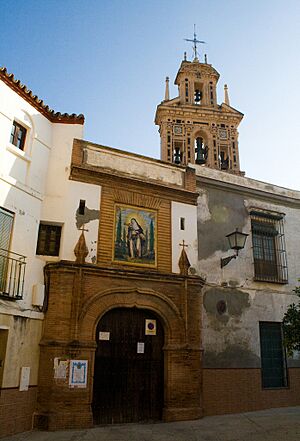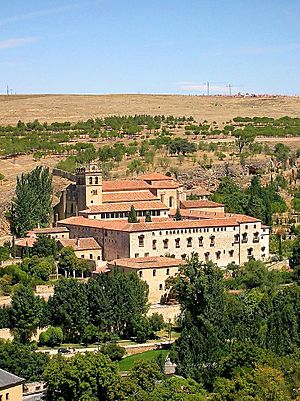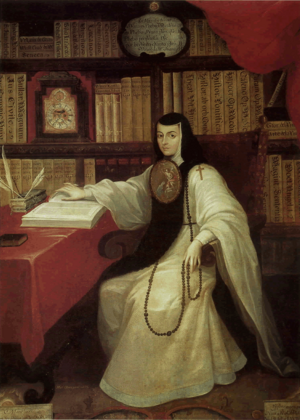Hieronymites facts for kids
The Hieronymites (pronounced: High-ruh-NIM-ites), also known as the Order of Saint Jerome, are a special group of Catholic monks and nuns. They live a quiet life of prayer, following the teachings of an ancient scholar named Jerome. He lived in the 400s and was famous for studying the Bible.
This group of monks and nuns started in the Iberian Peninsula (which is Spain and Portugal) around the late 1300s. They wear a white robe called a tunic with a brown, hooded piece of cloth called a scapular. They also wear a brown mantle over it.
Contents
The Hieronymites of Spain and Portugal
How the Order Began
The Hieronymite order began with a few hermits in Spain and Portugal. Hermits are people who live alone to pray and focus on God. These hermits wanted to live more like Saint Jerome. Two of them, Pedro Fernández y Pecha and Fernando Yáñez y de Figueroa, thought it would be better to live together in a community.
So, they started the Monastery of Saint Bartholomew in a place called Lupiana. Pedro Fernández y Pecha became their first leader, called a prior. In 1373, Pope Gregory XI officially recognized them as a religious order. This meant they were a formal group within the Catholic Church. They followed a set of rules called the Rule of Saint Augustine, which included ideas from their patron saint, Jerome.
By 1415, there were 25 Hieronymite monasteries. The Pope then made them an "exempt order." This meant they were free from the direct control of local bishops.
The kings of Spain really liked the Hieronymites. Soon, the order had some of the most famous monasteries in Spain and Portugal. These included the amazing Monastery of Saint Mary of Guadalupe in Spain and the Royal Monastery of Saint Mary of Bethlehem in Lisbon, Portugal. King Philip II of Spain even built a magnificent monastery for them at El Escorial, where Spanish kings were buried.
Even though their life was very strict, the Hieronymites also spent time studying and helping people. They were very influential in the courts of Spain and Portugal. In the 1500s, they supported John of God, who started a nursing order to care for the sick. Hieronymite missionaries also traveled to the Americas. They helped spread Christianity in the New World.
Hieronymite nuns also started their own communities in 1375. They became very common throughout Spain and Portugal.
What They Wear
The monks and nuns of the Hieronymite order wear special clothes called a religious habit. It's a white tunic (a long robe) with a brown scapular. A scapular is a piece of cloth that hangs over the shoulders, front and back. They also wear a brown hood and a brown mantle (a type of cloak).
Their Work in the Americas
In the early 1500s, the Hieronymite monks were sent to the Caribbean islands, like Hispaniola. They were sent by Cardinal Francisco Jiménez de Cisneros. Their job was to look into reports of Spanish colonists treating the native people unfairly. A priest named Bartolomé de las Casas had spoken out strongly about these problems.
The monks tried to help, but it was very difficult to stop the unfair treatment. One of the monks, Luis de Figueroa, was later chosen to be the bishop of Santo Domingo in 1523. This area included Cuba and Puerto Rico. Sadly, he died before he could officially become a bishop.
The Order in Modern Times

The number of Hieronymite monks decreased a lot in the 1700s. In 1835, the Spanish government completely closed down their monasteries. At that time, there were 48 monasteries with about a thousand monks. Many of these old monastery buildings fell apart. Some were given to other religious groups, while others became farms or even vacation homes.
However, the Hieronymite nuns were not affected by this closure. In 1925, they asked the Church to bring back the men's branch of the order. This was allowed, and a new community of monks was started at the Monastery of Saint Mary of Parral in Segovia, Spain. But political problems in Spain in the 1930s meant that the order didn't really grow much until 1969.
As of 2012, there is one community of Hieronymite monks at Saint Mary of Parral. There are also 18 monasteries of Hieronymite nuns. Seventeen of these are in Spain, and one is in India.
The Hieronymite order today is focused on a quiet life of prayer and reflection. They believe that by living in solitude and silence, praying, and doing good works, they can become closer to God. They feel that their prayers can have a big impact on the world outside the monastery.
Hieronymite monks usually spend their mornings doing manual work, which helps support the monastery. Afternoons are for quiet thought, prayer, and study. Throughout the day, they gather to sing prayers and celebrate the Eucharist (a special religious service). They try to make prayer a part of everything they do.
The Hieronymites believe that this quiet way of life is a powerful way to help others. They welcome visitors who want to experience silence and prayerful support.
In 2010, there were 11 monks in the order, with four of them being priests.
The Hieronymite Nuns
The Hieronymite nuns started in Toledo, Spain. In 1374, a group of women led by María García and Mayor Gómez began living simple lives of prayer. They decided to live together to dedicate their lives to God. Pedro Fernández y Pecha, the prior of the first Hieronymite monks, helped guide them. He set up a way of life for them that was similar to the monks.
This first group of nuns started the Monastery of Saint Paul. They were sometimes called the "beatas de San Jerónimo" (blessed women of Saint Jerome). Because they followed their rules well and lived holy lives, their communities spread. They established monasteries throughout Spain and even in New Spain (which is now Mexico). In 1585, the convent of San Jerónimo y Santa Paula was founded in Mexico City. One of its most famous members was a nun named Sor Juana Inés de la Cruz in the 1600s. She was known as "the Tenth Muse" because she was a brilliant writer and scholar.
Current Hieronymite Communities
Monks (Cloistered)
Nuns (Cloistered)
- Monastery of Saint Paul (Toledo, Spain) – Started in 1464
- Monastery of Saint Martha (Cordoba, Spain) – Started in 1464
- Monastery of Saint Paula (Seville, Spain) – Started in 1475
- Monastery of Saint Matthew (Barcelona, Spain) – Started in 1475
- Monastery of Santa Mary of the Conception (Trujillo, Cáceres, Spain) – Started in 1478
- Monastery of Saint Elizabeth (Palma de Mallorca, Spain) – Started in 1485
- Monastery of the Hieronymite Conception (Madrid, Spain) – Started in 1504
- Monastery of Saint Bartholomew (Inca, Balearic Islands, Spain) – Started in 1530
- Monastery of Saint Paula (Granada, Spain) – Started in 1540
- Monastery of Saint Mary of the Assumption (Morón de la Frontera, Seville, Spain) – Started in 1568
- Monastery of Our Lady of Remedies (Yunquera de Henares, Guadalajara, Spain) – Started in 1572
- Monastery of Our Lady of Health (Garrovillas, Cáceres, Spain) – Started in 1572
- Monastery of Corpus Christi las Carboneras (Madrid, Spain) – Started in 1605
- Monastery of Our Lady of the Angels (Constantina, Seville, Spain) – Started in 1951
- Monastery of Our Lady of Mercy (Almodóvar del Campo, Ciudad Real, Spain) – Started in 1964
- Monastery of Saint Mary of Jesus (Cáceres, Spain) – Started in 1975
- Monastery of Our Lady of Bethlehem (Toral de los Guzmanes, León, Spain) – Started in 1990
- Monastery of Mater Ecclesiae (Punalur, Kerala, India) – Started in 2000
Images for kids
-
Saint Jerome with Saint Paula and Saint Eustochium (painting by Francisco de Zurbarán).
See also
 In Spanish: Orden de San Jerónimo para niños
In Spanish: Orden de San Jerónimo para niños
- Marcella: A friend of Saint Jerome.
- Monastery of Sant Jeroni de Cotalba (Valencia, Spain)
- Cristobal de Vera








